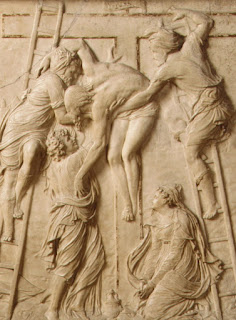Jesus said to them,
“When you lift up the Son of Man,
then you will realize that I am,
and that I do nothing on my own,
but I say only what the Father taught me.
The one who sent me is with me.
He has not left me alone,
because I always do what is pleasing to him.”
Because he spoke this way, many came to believe in him.
Jesus tells us that when he is lifted up, he will draw everyone to himself. Clearly his “lifting up” is his crucifixion. He will be raised up on a cross of humiliation, pain and death; and his lifting up will be his self-gift to his Father for us. And when he says, “Where I am, there also will my servant be,” it is because he longs to draw us with himself to the Father through the narrow gate of his passion.
Follower of Jean Goujon (French, ca. 1510–ca. 1565 Bologna (?)), after a composition by Marcantonio Raimondi, ca. 1555, marble with traces of gilding, 43 1/4 x 24 1/2 in. The Metropolitan Museum of Art. Used with permission.
“When you lift up the Son of Man,
then you will realize that I am,
and that I do nothing on my own,
but I say only what the Father taught me.
The one who sent me is with me.
He has not left me alone,
because I always do what is pleasing to him.”
Because he spoke this way, many came to believe in him.
Jesus tells us that when he is lifted up, he will draw everyone to himself. Clearly his “lifting up” is his crucifixion. He will be raised up on a cross of humiliation, pain and death; and his lifting up will be his self-gift to his Father for us. And when he says, “Where I am, there also will my servant be,” it is because he longs to draw us with himself to the Father through the narrow gate of his passion.
Still In the face of the ultimate
inevitability of our death, our one time dying, and our daily dyings, we may want to run away. But Jesus offers us the cross a way out. He longs to draw us
into his own his loving self-offering as a way out of death as dead end-
self-giving as a way that absolutely cancels death, smashes it to pieces
forever. “For the joy that lay before him, he
endured the cross despising its shame,” because he knows that death is only a
gateway to life in love. We need not be afraid.
Follower of Jean Goujon (French, ca. 1510–ca. 1565 Bologna (?)), after a composition by Marcantonio Raimondi, ca. 1555, marble with traces of gilding, 43 1/4 x 24 1/2 in. The Metropolitan Museum of Art. Used with permission.

